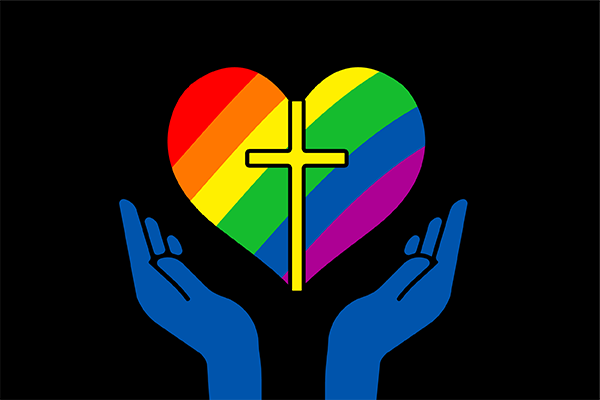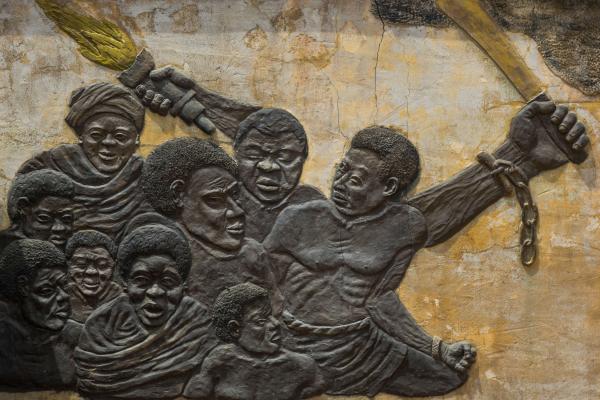This article is part of the series, The Joy of Being Queer and Christian; new articles will be added throughout the month of June.
The first rainbow flag to represent the LGBTQ+ community was created by artist and activist Gilbert Baker in 1978. At the time, the gay rights movement was mobilizing under the reclaimed symbol of the pink triangle, which had been used by the Nazis to brand gay men in the concentration camps of World War II. However, as the movement continued to grow and incorporate people of different identities, a new symbol was needed to represent the full scope of this evolving community. Gilbert and his fellow activists chose a rainbow and since then, the flag has stood as an emblem of justice, equality, and love for queer people around the world.
As a Christian and a gay man, I have always loved how the colors of the rainbow flag speak to both sides of my identity. Though some colors have been removed or added over the years for different reasons, six of the original colors continue to exemplify the shared humanity of everyone who marches under their banner. Each color has a meaning that carries deep significance for the LGBTQ+ community. At the same time, there is a biblical connection to the rainbow that speaks to the promises of God. This Pride month, I feel it’s worthwhile to reflect on what each color has to teach us about God and ourselves.
Red: Life
One of the difficult things about being part of the queer community is how often we have to face the specter of death. From the Holocaust, to the AIDS crisis, to the heightened risk of suicide among LGBTQ+ teens, queer people have been bombarded with hateful treatment that says our lives are worthless. The story of the first rainbow tells us differently.
The first mention of a rainbow in scripture appears during the story of Noah in the book of Genesis (Genesis 9). Following the devastation of the great flood, God sets a rainbow in the sky as a sign that he will never again destroy all life in such a way. God makes this promise freely, without conditions, and its protection extends well beyond the lives of Noah and his descendants. God emphasizes, throughout the passage, that this new covenant is between him and every living creature on earth. It’s appropriate then, that the first color of the rainbow should symbolize life.
The rainbow tells us that every queer person was created in the image of a God who loves and treasures them. It continues to testify to this truth, reminding us that even when storm clouds begin to gather, we can still find hope in the promise of tomorrow.
Orange: Healing
Jesus and healing are practically synonymous. Throughout his ministry on earth, people gathered to Jesus because they believed he could heal their afflictions and make them whole. The blind (Matthew 9:27-29), the chronically ill (Matthew 9:20-22), and those haunted by demons (Matthew 8:28-34) — each had an encounter with Christ that left them renewed in both body and soul. Many queer people also come to Christ seeking healing, though our wounds tend to be more complex.
Those of us who grew up in the church often carry intense feelings of anger and grief for how we have been treated. The mental, emotional, and spiritual wounds inflicted on us by nonaffirming Christians can run so deep that true healing seems impossible. Nonaffirming Christians would have queer people believe that our sexualities are what require healing. But what Christ ultimately wants to heal is our bitterness, fear, and shame so that we can fully embrace our identities as queer disciples and take our place within his beloved community.
Yellow: Sunlight
Humans need sunlight. As diurnal creatures, our bodies and minds function at their best during the daylight hours. Our ability to see and distinguish color is dependent on the presence of light. Sunlight also boosts our mood and contributes to our overall mental health. In short, we were created to live in the light.
Similarly, Christians are meant to live in a spiritual light by producing things that are good, righteous, and true (Ephesians 5:8-9). Being a loyal friend, a loving spouse, or a supportive neighbor can be just as life-giving to humans as rays from the sun, and few groups understand this better than the LGBTQ+ community. “Found family” — that is, a family group built around mutual commitment, affection, and understanding rather than biological relation — and hospitality are staples of queer fellowship. To be fully known and seen by others is something each of us craves deep within our souls.
The beauty of authentic fellowship — whether experienced in the church or the queer community — is that it allows us to meet this need through the sharing of our joy, our pain, and even the simplicity of our lives. Just as the sun calls us to rise with each new day, Jesus calls his queer followers to live an illuminated life.
Green: Nature
Christians are taught that God created the world and at the end of each day, God looked upon his creation and saw that it was good (Genesis 1). Even the fall of Adam and Eve couldn’t rob God’s creation of its goodness. So, it’s very comforting when a queer person looks around this great, wide universe and finds they play a part in its beauty.
From fish who change their gender, to same-sex animal parents, it turns out we are not as “unnatural” as some nonaffirming Christians would like to believe. Queer people sin and fail just like everyone else, but our queerness is not a result of the fall. We, too, are fearfully and wonderfully made (Psalm 139:14), and like all of God’s creations, when God looks upon us God calls us good.
Blue: Harmony
In his book When We Rise: My Life in the Movement, LGBTQ+ activist Cleve Jones observes that queer individuals can be found in every racial, ethnic, religious, and economic background.
“Our people do not necessarily have anything in common,” he writes, “aside from their sexual orientation or gender identity and the social consequences of that orientation or identity.”
Yet despite our differences, divisions, and frequent conflicts, LGBTQ+ people still find ways to come together in solidarity. In this sense, the queer movement and the church share a similar vision of God’s beloved community.
At their best, both groups strive to make the world a better place. They champion justice, equality, and peace while serving as a home for the oppressed and vulnerable. At their worst, they dissolve into factions that are motivated entirely by ego and selfish ambition. The book of Romans tells us that God’s work is accomplished when humans live in harmony with one another, using their diverse talents and identities to serve others in humility (Romans 12). What could our world look like if both groups followed this example and chose harmony over dogma?
Violet: Spirit
There are plenty of reasons to be anxious this Pride month. Emboldened by a growing slate of anti-LGBTQ+ laws, many conservatives have championed increasingly hostile boycotts of businesses and organizations that voice support for LGBTQ+ people. Christians, meanwhile, have continued to use hateful rhetoric in an effort to slander and demonize the queer community.
While it’s tempting to fixate on what lies ahead, the Spirit of God asks us to consider what we are doing in the here and now. The Catholic priest Henri J.M. Nouwen wrote in Following Jesus that, “We have to learn to live fully in the present, because God is always the God of now, of here. The day in which we live is the day of the Lord. If anything is happening that is spiritually valid, it is happening here and now, at this moment. As you sit here. As you pray. It is always here.”
The truth is that tomorrow will always be a source of worry (Matthew 6:34). Today though, is an opportunity for us to do good, to be kind, and to grow as followers of Jesus. The Spirit is what draws us to these moments, helping us attend to what matters and take those small but important steps in the long journey of faith.
My deepest prayer this day is that all Christians, regardless of their sexual orientation or gender identity, would remember that God invites us to life. Through Jesus, our deepest pains are healed, and our hearts are filled with all the warmth and joy of a new dawn. God shows queer people that we are a precious part of God’s creation, treasured members of the beloved community, and that even in the midst of struggle, the Spirit of God is at work in our lives and relationships.
This is the good news I remember whenever I see a rainbow flag hanging in a window or waving in the breeze. It is the message that we are loved by an amazing God and that the greatest gift we can give is to love others in return.
Got something to say about what you're reading? We value your feedback!







